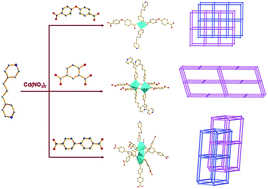Three new metal organic frameworks (MOFs) derived from the flexible dipyridyl ligand 1,3-bis(4-pyridyl)propane (BPP), Cd(BPP)(OBA)(H2O)·(DMF)(H2O) (1), Cd(BPP)(4-HOIP)·(DMF)0.5(H2O) (2), [Cd6(BPP)(BPDC)7(DMF)2]2−·(H3O+)2(H2O)7 (3), (H2OBA = 4,4′-oxybis(benzoic acid), 4-H3OIP = 4-hydroxyisophthalic acid, H2BPDC = 4,4′-biphenyldicarboxylic acid, DMF = N,N-dimethylformamide) have been synthesized under mild conditions. By changing the co-dicarboxylate ligands, the three structures are based on uni-, di-, and tri-nuclear Cd(II) SBUs (secondary building units). Notably, compound 3 has an unusual 3D pillared framework with 2-fold interpenetrated hex topology. Most interestingly, in compound 3, BPP and BPDC ligands play the roles of two kinds of pillars, and support the same 2D layers alternatively leading to a special anionic 3D framework. To the best of our knowledge, such an arrangement has not been reported to date. Moreover, the three compounds exhibit strong luminescent emission at room temperature in the solid state.

